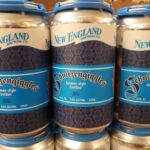A drink to conjure up fall Gemütlichkeit
By Frank Whitman
 I’m told that the most popular food at the Munich Oktoberfest is a large, soft pretzel. Beer is, not surprisingly, the most popular beverage. Together they conjure up the sights and smells of a great fall festival.
I’m told that the most popular food at the Munich Oktoberfest is a large, soft pretzel. Beer is, not surprisingly, the most popular beverage. Together they conjure up the sights and smells of a great fall festival.
Originally a celebration of the marriage of King Ludwig I and Princess Therese in 1810, Oktoberfest has morphed into a food and drink bacchanal hosting six million guests annually. But it’s much more than burley blonds in dirndls carrying handfuls of beer schooners to thousands of celebrants in vast tents. It’s a broader celebration of German culture.
 Still, I have to admit that the main attraction is the beer and food. Only these six Munich breweries are allowed to serve beer at the festival: Augustiner, Hacker-Pschorr, Hofbräu, Löwenbräu, Paulaner and Spaten.
Still, I have to admit that the main attraction is the beer and food. Only these six Munich breweries are allowed to serve beer at the festival: Augustiner, Hacker-Pschorr, Hofbräu, Löwenbräu, Paulaner and Spaten.
Oktoberfest food and drink has readily transferred to our neck of the woods. The rise in craft breweries has made the celebration a fall tradition. Brewpubs are awash in fest-style beers and gemütlichkeit. Restaurants have jumped on the beerwagon too. In Munich, hoping for the best weather, the festival starts in mid-September and runs through early October. Events here at home cover a longer season.
CTinsider.com has a comprehensive list of Connecticut events. Donnavans in SoNo has an Oktoberfest menu running all month with the good stuff – wurst, schnitzel, sauerbraten, potato pancakes and more – with some seasonal beers to go along. Westoberfest – A New England Craft Beer Tasting in Westport on October 14, offers a chance to taste an array of craft beers and good eats. Advance tickets are a good idea.
 Store shelves are laden with variations on thematic beers, most carrying the name Oktoberfest with some fine print below. A few go for cute, like New England Brewing with the name Schintzengiggles.
Store shelves are laden with variations on thematic beers, most carrying the name Oktoberfest with some fine print below. A few go for cute, like New England Brewing with the name Schintzengiggles.
Most are labeled Marzen. The Germans put an umlaut over the A but the Americans skip it. Marzen is the style of beer originally served at the Munich Oktoberfest. These days it has been pushed out of the top spot by the Hellas style that is a light golden color with more hop character.
Rich, dark, malty Marzen is a traditional German beer born of necessity. Before refrigeration, beer could not be brewed in the warm summer months when the heat made the process unreliable and the flavors undependable. Marzen was brewed in its namesake month, March, and lagered (stored in cool caves) to mature. It was the only beer available in the early fall until temperatures were cool enough to resume  brewing. With refrigeration, beer is made year round and Marzen has become a seasonal specialty.
brewing. With refrigeration, beer is made year round and Marzen has become a seasonal specialty.
The Beer Advocate defines Marzen as, “A full-bodied lager that’s rich, malty (toasty, bready, biscuity, caramel, roasty), moderately hopped (floral, spicy, herbal), and finishes clean and dry like a good lager should.” It’s a tasty brew, but the rich malty character is out of fashion these days. Bright citrusy, floral hops that are so popular in IPAs are nowhere to be seen.
Make no mistake. This is not pumpkin or pumpkin spice beer that is also popular in the fall. That’s a completely separate category.
 German beers are carefully regulated by law to be true to type. You won’t find crazy experimentation in traditional categories. That’s not true here. Beer writer and Director of the Great International Beer, Cider, Mead & Sake Competition, Gregg Glazer told me, “This is America! We do whatever we damn well please!”
German beers are carefully regulated by law to be true to type. You won’t find crazy experimentation in traditional categories. That’s not true here. Beer writer and Director of the Great International Beer, Cider, Mead & Sake Competition, Gregg Glazer told me, “This is America! We do whatever we damn well please!”
As a result, there’s considerable variation in American Oktoberfest beers. Some hew closely to the Marzen style while others take it as a point of departure, modifying the malt, adding hops or just riffing on the idea. There’s some fun to be had tasting an array of fest beers. Get together a gang, warm up some soft pretzels and dive in. For a more ambitious occasion, whip up a batch of Schnitzel.
 Marsha and I compared an Oktoberfest Marzen Lager from Brooklyn Brewery with a classic German Paulaner Marzen. The copper colored Marzen from Brooklyn sported some hop brightness while the Paulaner’s caramel color predicted a rich malt character. Both were refreshing, made a good match with pork shoulder slow-braised with apricots, and brought on that feeling of fall gemütlichkeit.
Marsha and I compared an Oktoberfest Marzen Lager from Brooklyn Brewery with a classic German Paulaner Marzen. The copper colored Marzen from Brooklyn sported some hop brightness while the Paulaner’s caramel color predicted a rich malt character. Both were refreshing, made a good match with pork shoulder slow-braised with apricots, and brought on that feeling of fall gemütlichkeit.
Prost!












No Comment